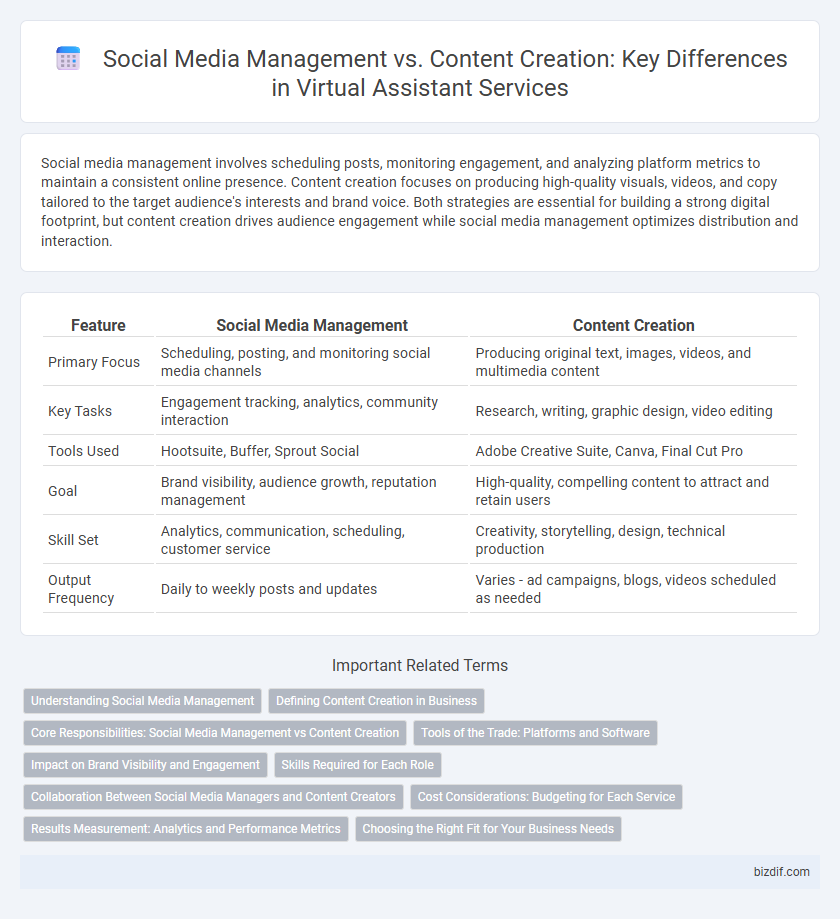Social media management involves scheduling posts, monitoring engagement, and analyzing platform metrics to maintain a consistent online presence. Content creation focuses on producing high-quality visuals, videos, and copy tailored to the target audience's interests and brand voice. Both strategies are essential for building a strong digital footprint, but content creation drives audience engagement while social media management optimizes distribution and interaction.
Table of Comparison
| Feature | Social Media Management | Content Creation |
|---|---|---|
| Primary Focus | Scheduling, posting, and monitoring social media channels | Producing original text, images, videos, and multimedia content |
| Key Tasks | Engagement tracking, analytics, community interaction | Research, writing, graphic design, video editing |
| Tools Used | Hootsuite, Buffer, Sprout Social | Adobe Creative Suite, Canva, Final Cut Pro |
| Goal | Brand visibility, audience growth, reputation management | High-quality, compelling content to attract and retain users |
| Skill Set | Analytics, communication, scheduling, customer service | Creativity, storytelling, design, technical production |
| Output Frequency | Daily to weekly posts and updates | Varies - ad campaigns, blogs, videos scheduled as needed |
Understanding Social Media Management
Social media management involves strategic planning, scheduling, and monitoring of posts across multiple platforms to maximize audience engagement and brand presence. It requires analyzing metrics, responding to community interactions, and optimizing content delivery times to boost visibility and growth. Efficient social media management ensures consistency, brand alignment, and real-time adaptation to evolving trends and audience behavior.
Defining Content Creation in Business
Content creation in business involves producing engaging and relevant multimedia such as articles, videos, and graphics tailored to target audiences. It drives brand awareness, enhances customer engagement, and supports marketing objectives by delivering valuable information that resonates with potential customers. Effective content creation requires strategic planning, creativity, and a clear understanding of audience needs to maximize return on investment.
Core Responsibilities: Social Media Management vs Content Creation
Social media management centers on strategizing, scheduling, and analyzing posts to engage and grow an online audience while monitoring brand reputation across platforms like Facebook, Instagram, and Twitter. Content creation involves producing original multimedia materials such as articles, videos, graphics, and podcasts tailored to enhance brand messaging and drive user interaction. Both roles require collaboration but differ as social media management emphasizes audience engagement metrics and campaign optimization, whereas content creation focuses on the development of compelling and shareable content assets.
Tools of the Trade: Platforms and Software
Social media management relies heavily on tools like Hootsuite, Buffer, and Sprout Social for scheduling, analytics, and engagement tracking across platforms such as Facebook, Instagram, and LinkedIn. Content creation demands software like Adobe Creative Suite, Canva, and Final Cut Pro to design visually appealing graphics, videos, and written posts tailored for these channels. Both disciplines benefit from integrated platforms like Later and Loomly, which streamline workflow by combining scheduling and creative capabilities.
Impact on Brand Visibility and Engagement
Social media management streamlines scheduling, monitoring, and interacting on platforms, directly enhancing brand visibility through consistent presence and timely responses. Content creation fuels engagement by producing compelling, tailored posts that resonate with target audiences and foster community interaction. Effective integration of both functions maximizes brand awareness and deepens customer relationships across digital channels.
Skills Required for Each Role
Social media management demands skills in analytics, audience engagement, and platform-specific tools like Facebook Insights and Hootsuite, emphasizing strategic planning and real-time interaction. Content creation requires proficiency in graphic design, copywriting, and video editing software such as Adobe Creative Suite and Final Cut Pro, focusing on creativity and storytelling to develop compelling visuals and messages. Both roles benefit from strong communication skills, but social media managers prioritize campaign optimization, whereas content creators excel in producing original multimedia content.
Collaboration Between Social Media Managers and Content Creators
Collaboration between social media managers and content creators enhances brand consistency and audience engagement by aligning strategic goals with creative output. Social media managers analyze platform analytics and audience behavior to guide content creators in producing tailored, optimized posts that drive interaction and growth. Seamless communication and shared tools enable the team to adapt quickly to trends, ensuring timely and relevant content delivery across channels.
Cost Considerations: Budgeting for Each Service
Social media management typically involves ongoing costs such as platform subscriptions, scheduling tools, and community engagement, which can accumulate significantly over time. Content creation often requires investment in professional photography, video production, graphic design, and copywriting services, leading to higher upfront expenses. Budgeting effectively requires evaluating the frequency of posts, quality expectations, and resource allocation to balance cost efficiency between managing social channels and producing compelling content.
Results Measurement: Analytics and Performance Metrics
Social media management leverages analytics tools to track engagement rates, follower growth, and post reach, providing clear performance metrics to optimize campaigns. Content creation focuses on measuring content-specific KPIs such as views, shares, and conversion rates to evaluate creativity impact. Both disciplines require detailed results measurement to refine strategies and enhance overall digital presence.
Choosing the Right Fit for Your Business Needs
Social media management focuses on scheduling, monitoring, and engaging with your audience across platforms, ensuring consistent brand presence and timely responses. Content creation emphasizes producing high-quality visuals, videos, and written posts tailored to your target demographic, fostering brand storytelling and engagement. Businesses need to evaluate whether their priority is ongoing community interaction or generating fresh, compelling content to determine the best virtual assistant service fit.
Social media management vs Content creation Infographic

 bizdif.com
bizdif.com